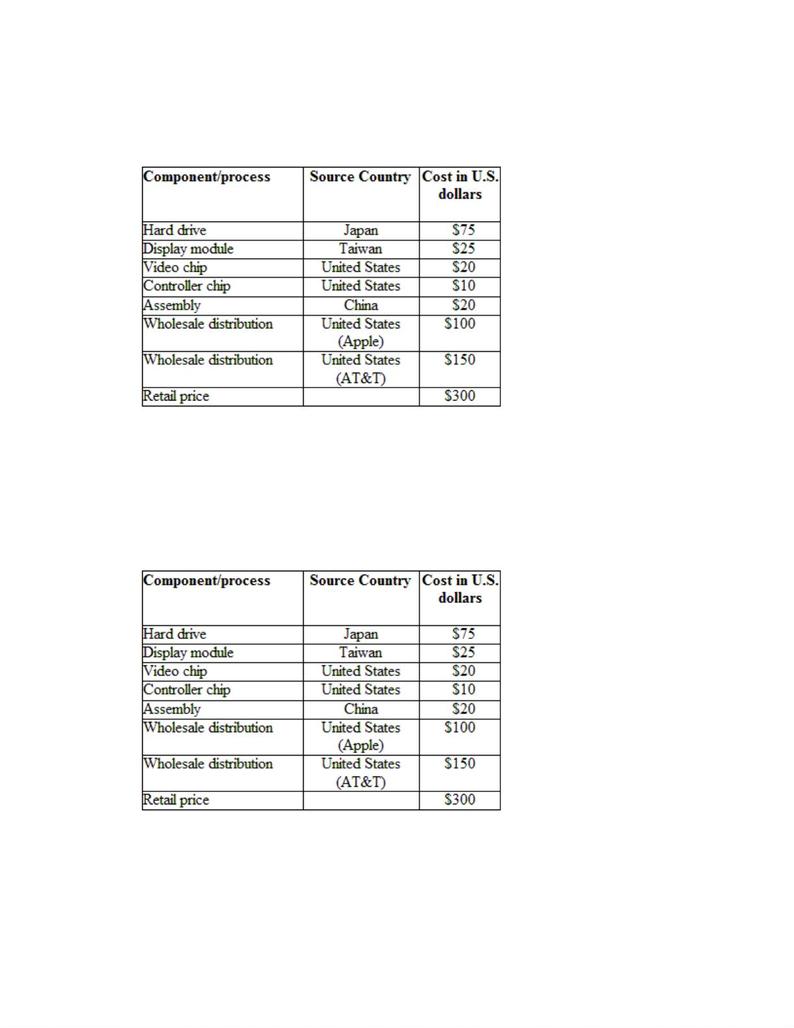
Page 1
1.
What country was the world's largest exporter of goods in 2014?
A)
China
B)
Germany
C)
the United States
D)
Japan
2.
Which of the following is an example of trade of goods, otherwise known as trade flow?
A)
Robert Feenstra purchases $100 million of British treasury bonds.
B)
Robert Feenstra purchases a yogurt factory in France.
C)
Robert Feenstra purchases a British-made Range Rover.
D)
Robert Feenstra purchases 100 shares of Novartis AG, a Swiss pharmaceutical
company.
3.
Currently, which of the following countries is the world's largest exporter of goods (in
dollar volume)?
A)
China
B)
the United States
C)
Japan
D)
Germany
4.
Currently, which of the following countries is the world's largest exporter of goods and
services (in dollar volume)?
A)
China
B)
the United States
C)
Japan
D)
Germany
5.
Which of the following is an example of a service export?
A)
Universal Pictures licenses the right to show the movie Jurassic Park to a Chinese
theater chain.
B)
Joan Brown migrates from the United States to Canada.
C)
Tom Jones purchases 100 shares of Eaton Corporation, an Irish company.
D)
Monique le Flambeau, a French citizen, purchases a Ford F150 while visiting the
United States.

Page 2
6.
What is the term for a capital flow that is used to purchase or build a tangible asset like
a factory?
A)
migration
B)
service exports
C)
service imports
D)
foreign direct investment
7.
What is the name given to a tax on imported goods?
A)
income tax
B)
tariff
C)
sales tax
D)
excise tax
8.
When a foreign resident purchases a good or service from someone in the United States,
the transaction is:
A)
a U.S. export.
B)
a U.S. import.
C)
bilateral exchange.
D)
a compensating differential.
9.
Imports are:
A)
goods or services purchased from a foreign resident.
B)
goods or services sold to foreign residents.
C)
goods only purchased from foreigners—you cannot purchase services from
foreigners.
D)
services only—imports do not include goods.
10.
Exports are:
A)
goods or services purchased from a foreign resident.
B)
goods or services sold to foreign residents.
C)
goods only sold to foreigners—you cannot sell services to foreigners.
D)
services only—exports do not include goods.
11.
Which of the following entries is considered a service export?
A)
Japan buys soybeans from the United States.
B)
China sells iPhones to the United States.
C)
Mexican tourists visit the Grand Canyon.
D)
France sells wine to the United States.

Page 3
12.
Which of the following transactions is NOT a trade flow?
A)
domestic residents' purchases of foreign-made goods
B)
domestic residents' purchases of foreign-provided services
C)
domestic residents' purchases of foreign stocks and bonds
D)
domestic residents' purchases of foreign-produced software
13.
A country's service exports include:
A)
a restaurant meal purchased by its resident in another country.
B)
equipment or automobiles with a warranty and a service contract sold to a foreign
resident.
C)
a ticket on a country's airline sold to a foreign resident.
D)
a country's resident who migrates to work in another country.
14.
The difference between the total value of a country's exports and the total value of its
imports is defined as the country's:
A)
trade status.
B)
trade balance.
C)
trade deficit.
D)
bilateral trade balance.
15.
An American tourist buys a ticket to an opera in Paris. The U.S. government classifies
this transaction as:
A)
a goods' import of a French Opera.
B)
a service export.
C)
a service import.
D)
a goods' export.
16.
A Chinese student pays tuition at a U.S. university. The Chinese government classifies
this transaction as:
A)
a goods' import.
B)
a service export.
C)
a service import.
D)
a goods' export.
17.
If the value of a nation's imports is more than the value of its exports, then the nation is
experiencing:
A)
a trade deficit.
B)
a trade surplus.
C)
balanced trade.
D)
a trade balance.

Page 4
18.
If country X has a GDP of $1 trillion, exports $200 billion to country Y, and imports
$300 billion from country Y, then its bilateral trade balance with country Y is:
A)
–$100 billion.
B)
$100 billion.
C)
$500 billion.
D)
50%.
19.
Which of the following is classified as a United States service export?
A)
Renee LaFrancois, a French citizen, has her hair dyed in a New York salon.
B)
Miguel Ramirez, a Mexican citizen, gets paid for working in a Kansas
vegetable-canning factory.
C)
Harvey Guelph, a U.S. citizen, gets his haircut in a British barber shop.
D)
Marie Thompson, a U.S. citizen, purchases a bottle of champagne in a French
grocery store.
20.
The difference in value between a nation's exports and imports is called:
A)
its trade deficit.
B)
its bilateral trade balance.
C)
balanced trade.
D)
its trade balance.
21.
Whenever the value of a nation's exports is more than the value of its imports, the nation
has:
A)
a trade deficit.
B)
a trade surplus.
C)
balanced trade.
D)
a trade balance.
22.
Whenever the value of a nation's exports is less than the value of its imports, the nation
has:
A)
a trade deficit.
B)
a trade surplus.
C)
balanced trade.
D)
a trade balance.

Page 5
23.
Whenever the value of a nation's exports equals the value of its imports, the nation is
experiencing:
A)
a trade deficit.
B)
a trade surplus.
C)
balanced trade.
D)
a trade balance.
24.
A bilateral trade balance is:
A)
half the trade deficit.
B)
the measure of imports only—not exports.
C)
the difference between the value of imports and exports between two trading
nations.
D)
the sum of the value of imports and exports traded between two nations.
25.
What entries are used to calculate a country's bilateral trade balance?
A)
its unemployment and inflation rates
B)
its exports to and imports from another country
C)
its per capita income and imports
D)
its exports and per capita income
26.
Which of the following statements about the United States–China bilateral trade balance
is correct?
A)
It is a good indicator of the inequality of imports and exports between the United
States and China.
B)
It vastly understates the gap in imports and exports between the United States and
China.
C)
It may overstate the gap in imports and exports between the United States and
China because some material inputs used to produce Chinese exports do not
originate in China.
D)
It shows that there is balanced trade between the United States and China.
27.
The United States–China bilateral trade balance may overstate the trade gap if:
A)
some of the inputs used to produce Chinese exports are imported.
B)
none of the inputs used to produce Chinese exports are imported.
C)
Chinese exports are valued in the United States versus Chinese currency.
D)
the United States imposes trade restrictions on Chinese imports.

Page 6
28.
“Value-added” in the context of international trade refers to:
A)
the difference between the value of exports and the value of imported inputs used
in producing exports.
B)
the additional value a worker provides to a firm when she is hired.
C)
the value-added by being able to purchase goods in a competitive market.
D)
the value-added by import brokers when they mark up the price of the products.
29.
Recent bilateral trade data alarm politicians who worry about China's growing trade
imbalance with the United States. What do the authors of your textbook say?
A)
The real data are even more shocking.
B)
It is not as bad as the numbers appear because China imports a large percentage of
the value of its exports to the United States from its other trading partners.
C)
It depends on how you count imports and exports and on which currency is used.
D)
Irresponsible governments, corruption, and greedy corporations are responsible for
the widening gap.
30.
How has China explained its growing bilateral imbalance with the United States?
A)
Current accounting practices make it very difficult to determine the value-added
and true national origin of goods.
B)
If the United States would only improve its efficiency, there would be no gap.
C)
Most Chinese imports are cheap consumer goods, and no firm in the United States
wants to make those things anyway.
D)
China continues to struggle with corrupt officials at the customs bureau.
31.
How does one determine the “value-added” of a product produced and sold
domestically?
A)
Subtract the total value of imported raw and semi-finished materials used in
production from the product's total value.
B)
Add the cost of its transportation to its market to the product's total value.
C)
Subtract the total value of all raw and semi-finished materials used in its
production from the product's total value.
D)
Subtract the total value of a country's imports from the total value of its exports.
32.
Jane Ferlengeti, a U.S. citizen, purchases a phone for $300 that Apple imported from
China. Apple paid its Chinese subsidiary $150 for the phone. How did these transactions
change the U.S.–Chinese bilateral trade balance?
A)
It improved (i.e., increased) by $300.
B)
It worsened (i.e., fell) by $300.
C)
It worsened by $150.
D)
It did not change the U.S.-–Chinese trade balance, since Apple's $150 margin
($300–$150) offset the $150 cost of importing the phone from China.

Page 7
33.
(Table: Costs Associated with Phone Supply Chain) Jane Smith, a U.S. citizen,
purchases a phone from AT&T for $300. By how much did Jane's purchase change the
U.S. trade balance with China?
A)
$300
B)
$150
C)
$120
D)
$30
34.
(Table: Costs Associated with Phone Supply Chain) Jane Smith, a U.S. citizen,
purchases a phone from AT&T for $300. By how much did Jane's transaction affect the
U.S.–Japanese trade balance?
A)
It did not affect it at all.
B)
The U.S.–Japanese trade balance fell by $750.
C)
The U.S.–Japanese trade balance rose by $130.
D)
The U.S.–Japanese trade balance fell by 25%.

Page 8
35.
Intel, an American company, has manufacturing plants in China that assemble
U.S.-made components. Suppose one of these plants produces and sells a computer chip
to a Chinese computer manufacturer. How is this sale recorded in U.S. international
trade statistics?
A)
It is considered to be neither a U.S. import nor a U.S. export.
B)
It is considered to be a U.S. export to China
C)
It is considered to be a U.S. import from China
D)
The value of U.S.-made chip components is considered to be a U.S. export.
36.
Why should the recorded U.S.–Chinese bilateral trade deficit in goods be interpreted
with some caution?
A)
U.S. imports of Chinese products may be produced by U.S. subsidiaries that
generate profits for the U.S. parent firms (recorded as U.S. service export income).
B)
U.S. imports of Chinese products may utilize material inputs that China imports
from the United States.
C)
U.S. imports of Chinese products may be produced with capital goods (e.g.,
machinery) that China imports from the United States.
D)
China does not record all of its imports from the United States in its trade statistics.
37.
An example of “value-added” as an important concept for international trade was the
case of imports of iPhones from China. The value-added by China was equal to:
A)
the total value of imported raw and semi-finished materials into China plus the
value of the export to the United States.
B)
the total value of the export to the United States minus the total value of imported
raw and semi-finished materials into China.
C)
the total value of the export plus shipping costs.
D)
the difference between the total values of exports to the United States minus the
total value of imports from the United States.
38.
Merchandise trade among European countries accounted for approximately what share
of total world merchandise (goods) trade in 2014?
A)
3%
B)
23%
C)
50%
D)
75%
39.
What nations have the world's highest volume of international trade with one another?
A)
Canada, Mexico, and Japan
B)
Japan, China, South Korea, and Thailand
C)
member nations of the European Union
D)
Middle Eastern countries

Page 9
40.
Which of the following countries was a member of the European Union prior to 2004?
A)
Poland
B)
Romania
C)
Hungary
D)
Italy
41.
Which of the following economic groupings has the largest volume of trade among its
member nations?
A)
NAFTA
B)
the European Union
C)
the Trans-Pacific Partnership
D)
the European Free-Trade Area
42.
How many countries are members of the European Union as of May 2016?
A)
5
B)
12
C)
22
D)
28
43.
What is the average tariff on intra-European Union trade?
A)
0%
B)
10%
C)
25%
D)
100%
44.
Which of the following countries is NOT a member of the European Union?
A)
Turkey
B)
Slovakia
C)
Hungary
D)
Poland
45.
Which of the following countries is NOT a member of the European Union?
A)
Denmark
B)
Finland
C)
Norway
D)
Sweden

Page 10
46.
U.S. and European merchandise trade accounted for approximately what share of total
world merchandise (goods) trade in 2014?
A)
slightly more than one fourth
B)
slightly more than one third
C)
about one half
D)
slightly more than two thirds
47.
Europe and the United States accounted for ______ of world exports in 2014.
A)
20%
B)
15%
C)
80%
D)
50%
48.
NAFTA is:
A)
a free-trade area among Mexico, Canada, and the United States.
B)
a trade agreement to limit environmentally dangerous imports and exports.
C)
a law preventing illegal immigration.
D)
another name for the European Union.
49.
Which of the following statements about trade is true?
A)
In 2014, Canada was the largest exporter to the United States.
B)
Trade volume among China, Japan, Thailand, and Taiwan is the world's largest.
C)
Trade volume among Chile, Brazil, Argentina, and Mexico is the world's largest.
D)
The combined trade volume of the United States and the European Union is the
world's largest.
50.
Which of the following statements explains why Asian countries such as China and
Vietnam export goods to industrialized countries?
A)
Workers in China and Vietnam receive low wages.
B)
Workers are more productive in China and Vietnam than in industrialized
countries.
C)
China and Vietnam have an abundant supply of raw materials.
D)
Chinese and Vietnamese factories are more technologically advanced than those in
industrialized countries.
51.
What was Africa's share of world exports in 2014?
A)
2%
B)
12%
C)
1.5%
D)
58%

Page 11
52.
Which of the following statements best explains the low level (about $35 billion) of
trade between the United States and Russia?
A)
Russia doesn't produce goods that Americans want to buy.
B)
The Russian market is smaller than the markets of most other countries.
C)
Political tensions between Russia and the United States reduce the level of trade
between the two countries.
D)
The United States has banned food imports from Russia.
53.
One way to gauge the impact of trade on a nation is to measure:
A)
wage distortions and job loss.
B)
the ratio of total imports and exports expressed as a percent of a nation's GDP.
C)
shipping costs.
D)
rises in national income due to trade.
54.
Which of the following is NOT included in the calculation of a country's gross domestic
product (GDP)?
A)
the value of all its intermediate goods produced in a year
B)
the value of all its exports produced in a year
C)
the value of all its final consumption goods produced in a year
D)
All of these are included in the calculation of a country's gross domestic product.
55.
If a country's GDP is $10 trillion, its exports are $1 trillion, and its imports are $1.5
trillion, then:
A)
its trade-to-GDP ratio is 10%.
B)
its trade-to-GDP ratio is 15%.
C)
its trade-to-GDP ratio is 25%.
D)
its trade-to-GDP ratio is 400%.
56.
Which of the following ratios is used to measure a country's openness to international
trade?
A)
the ratio of its exports to its GDP
B)
the ratio of its imports to its GDP
C)
the ratio of its trade balance (exports minus imports) to its GDP
D)
the ratio of its exports plus imports to its GDP

Page 12
57.
What does a country's gross domestic product (GDP) measure?
A)
the value of all intermediate goods produced in a year
B)
the value of all exports produced in a year
C)
the value of all final goods produced in a year
D)
the value of all production in a year
58.
If a country's GDP is $10 trillion and its overall trade flows are $2 trillion (exports plus
imports), then:
A)
its trade-to-GDP ratio is 20%.
B)
it is not a successful country.
C)
its GDP needs to increase.
D)
its trade-to-GDP ratio is too high.
59.
If a country's trade-to-GDP ratio is 38% and the GDP is $500 billion, then what is the
overall value of its trade (imports plus exports)?
A)
$390 billion
B)
$190 billion
C)
$100 billion
D)
Not enough information is provided to answer the question.
60.
If the trade-to-GDP ratio is 25% and the overall value of trade (imports plus exports) is
$175 billion, then the GDP is:
A)
$250 billion.
B)
$700 billion.
C)
$1 trillion.
D)
$0.5 trillion.
61.
The U.S. trade-to-GDP ratio is:
A)
the highest in the industrialized world.
B)
greater than China's and Japan's.
C)
smaller than that of Germany.
D)
too high.
62.
If we measure the ratio of total trade to GDP, which of the following nations had the
highest ratio in 2014?
A)
Hong Kong (China)
B)
Japan
C)
Germany
D)
the United States

Page 13
63.
Which of the following countries had the highest ratio of international trade to GDP in
2014?
A)
the United States
B)
Japan
C)
China
D)
Malaysia
64.
Which of the following nations had the lowest ratio of international trade to GDP in
2014?
A)
Hong Kong (China)
B)
Japan
C)
Germany
D)
the United States
65.
Why do larger countries tend to have lower ratios of international trade to GDP than
smaller countries?
A)
Larger countries tend to have more trade between states or provinces within their
borders than smaller countries.
B)
Larger countries tend to have higher tariffs than smaller countries.
C)
Larger countries tend to trade with other larger countries.
D)
Larger countries tend to have larger trade deficits than smaller countries.
66.
What is the best measure of a country's openness to international trade?
A)
the ratio of its exports to its GDP
B)
the ratio of its imports to its GDP
C)
the ratio of its trade balance (exports minus imports) to its GDP
D)
the ratio of its exports plus imports to its GDP
67.
Suppose that a country has a low ratio of trade to GDP. Which of the following may be
a possible explanation for this?
A)
The country has low tariffs on imports.
B)
The country is geographically distant from the rest of the world.
C)
The country is very large.
D)
The country produces only agricultural products.
68.
A tariff is:
A)
a tax on an import.
B)
a physical limitation on the quantity of imports of a certain good.
C)
a health or safety requirement on imports.
D)
a regulation affecting imports.

Page 14
69.
What is an import tariff?
A)
a limit on the imported quantity of a certain good
B)
a tax on the value of an import
C)
a health or safety precaution that affects goods that may cause long-term harm to
humans or animals
D)
a bureaucratic rule that can be overridden by the Secretary for International Trade
70.
What do economists call factors that reduce the total dollar volume of goods and
services sold across international borders?
A)
trade factor issues
B)
trade barriers
C)
trade conditions
D)
the ratio of total trade to GDP
71.
The “first golden age” of trade was:
A)
the period from 1864 to 1887.
B)
the period from 1890 to 1913.
C)
the period between 1919 and 1935.
D)
the inter-war period.
72.
One factor mentioned in the text as a reason for the “first golden age” of trade was:
A)
the invention of the cotton gin.
B)
the invention of the wheel.
C)
improved methods of transporting goods.
D)
the invention of the computer.
73.
Which decade of the twentieth century had the highest average tariffs worldwide?
A)
1900–09
B)
1930–39
C)
1950–59
D)
1970–79
74.
The Smoot–Hawley Tariff Act:
A)
was passed in response to World War II.
B)
was passed as a reaction to the Great Depression in the United States.
C)
was enacted by Germany.
D)
greatly reduced the barriers to trade.

Page 15
75.
What was the short-lived import tariff enacted in 1930 that raised rates to an average of
60% on many imports?
A)
the Reaganomics principle
B)
the Smoot–Hawley tariff
C)
the Blair-Bush tariff
D)
the International Equity tariff
76.
Other nations responded to the Smoot–Hawley tariff by:
A)
complaining to the United Nations.
B)
raising tariffs on imports in retaliation.
C)
lowering prices on exports in order to increase sales.
D)
attacking military bases in nations that refused to lower tariffs.
77.
What is an import quota?
A)
a limit on the quantity of a certain import
B)
a tax on the value of an import
C)
a health or safety precaution affecting goods that may cause long-term harm to
humans or animals
D)
a bureaucratic rule that can be overridden by the Secretary for International Trade
78.
What is the immediate effect of increasing tariffs in a country on its economy?
A)
It increases the volume of trade.
B)
It reduces the volume of imports.
C)
It increases the volume of exports.
D)
It promotes better trade relations with other countries.
79.
By 2012, the average worldwide tariff had fallen to about:
A)
35%.
B)
25%.
C)
15%.
D)
7%.
80.
What ushered in the “second golden age” of trade?
A)
the increase in trade among countries in the period after World War II
B)
the introduction of the gold standard
C)
the increase in trade restrictions as a reaction to the Smoot–Hawley tariff act
D)
the decline in volume of trade among industrialized countries

Page 16
81.
What was an eventual outcome of the Smoot–Hawley tariff enacted by the United
States?
A)
a renewed effort to reestablish international trade and the flow of payments via new
international organizations
B)
a focus on environmental and labor problems caused by trade
C)
a renewed emphasis on gold as a means of payment
D)
flows of foreign aid to low-income nations
82.
What lesson was learned from the imposition of the Smoot–Hawley tariff?
A)
Nations can usually work out their differences without any structure or
international organization.
B)
Tariffs are often necessary to keep trade fair.
C)
Retaliation and tariff escalation are not as harmful as many suppose.
D)
A reduction of trade as a result of a tariff imposes large costs on the countries
involved.
83.
After 1945, world trade:
A)
grew more slowly than in the decade before World War II.
B)
grew more rapidly than in the decade before World War II.
C)
grew in absolute dollar terms but not as a ratio of GDP.
D)
fell both in absolute and relative terms.
84.
What was the 1956 invention that increased the volume of world trade by lowering the
cost of shipping?
A)
the personal computer
B)
the bar code
C)
bubble wrap
D)
the shipping container
85.
The article “A Sea Change in Shipping 50 Years Ago” states that the amount of cargo
carried in a ship and the speed of the ship __________ from 1950 to 1976.
A)
increased
B)
decreased
C)
stayed the same
D)
were not related

Page 17
86.
According to the article “A Sea Change in Shipping 50 Years Ago,” what impact did
container shipping have on global trade?
A)
It increased the time taken to ship commodities.
B)
It decreased the volume of trade.
C)
It reduced the time that ships delivering goods spent at the port.
D)
It increased tariffs between countries.
87.
During the 2008–09 financial crisis, what happened to the ratios of trade to GDP for
most developed nations?
A)
They rose.
B)
They fell.
C)
They did not change.
D)
We do not have enough data yet to say what happened.
88.
What caused the decline in trade during the 2008–09 financial crisis?
A)
rising house prices, which took up more consumer income
B)
decreased demand during the crisis
C)
greater productivity in the developing countries
D)
pirate activity off the coast of Africa
89.
Which one of the following factors will contribute to continued growth of trade among
countries?
A)
Political pressures within industrialized countries to establish higher minimum
wages in developing countries.
B)
Declines in the importance of manufacturing in developing nations.
C)
Negotiation of more free-trade areas among countries.
D)
Increases in the average worldwide tariff.
90.
Which of the following statements best describes one of the textbook authors' views on
how global warming might affect international trade?
A)
It may reduce international trade as countries develop policies to offset global
warming.
B)
The melting of Arctic ice may allow cheaper and faster transportation of goods
between Asia and Europe.
C)
The melting of Arctic ice may allow cheaper and faster transportation of goods
between Europe and the United States.
D)
It may increase international trade as countries develop policies to offset global
warming.

Page 18
91.
The movement of people across borders is known as:
A)
resettlement.
B)
guest workers.
C)
migration.
D)
fractionalization.
92.
Which of the following countries is NOT a member of the Organization for Economic
Cooperation and Development?
A)
China
B)
the United States
C)
Germany
D)
the United Kingdom
93.
More than one half of migration is:
A)
from Organization for Economic Cooperation and Development (OECD) countries
to other OECD countries.
B)
from OECD countries to non-OECD countries.
C)
from non-OECD countries to OECD countries.
D)
from non-OECD countries to other non-OECD countries.
94.
In general, migration is _____ than trade.
A)
more free
B)
more controlled and regulated
C)
less desirable
D)
more desirable
95.
Immigration issues are usually more intense in:
A)
nations where wages are lower than world averages.
B)
nations with unsecured borders.
C)
nations with open-door policies.
D)
nations where wages are higher than world averages.
96.
Despite hopes that migration between nations in the European Union would be free,
several nations have agreements to restrict it. Why?
A)
They are afraid of disease.
B)
Labor policies are very different, and new workers will expect the same benefits.
C)
They are concerned that mass inflows of workers will lower wages and offer
competition for their own domestic labor force.
D)
Domestic workers are more productive.

Page 19
97.
Which country is the source of the largest number of immigrants from Latin America in
the United States?
A)
Brazil
B)
Colombia
C)
Mexico
D)
Venezuela
98.
What is a major concern of many Americans about the number of Mexican migrants in
the United States?
A)
Mexican migrants may petition the United States to adopt Spanish as its official
language.
B)
Mexican migrants may drive down wages of American workers.
C)
Many Mexican migrants never learn to speak English.
D)
Mexican migrants are displacing American workers in high-tech jobs.
99.
Which of the following is an example of a foreign direct investment (FDI) flow?
A)
the purchase of a controlling interest in a foreign firm by a domestic firm
B)
the purchase of stocks or bonds directly from an international dealer
C)
the purchase of foreign government bonds by domestic investors
D)
accounts denominated in foreign currency in foreign banks owned by domestic
depositors
100.
Most FDI flows are owned by:
A)
low-income nations.
B)
Australia.
C)
OECD nations.
D)
the African continent.
101.
Which of the following is NOT a reason for firms in an industrial nation to undertake
vertical FDI in a low-income nation?
A)
access to raw materials in the low-income nation
B)
lower wages in the low-income nation
C)
avoidance of export taxes in the low-income nation
D)
avoidance of import taxes in the low-income nation
102.
Most foreign direct investment among industrialized countries is:
A)
vertical FDI.
B)
horizontal FDI.
C)
industrial FDI.
D)
reverse-vertical FDI.

Page 20
103.
Which of the following is considered to be an outflow of foreign direct investment
(FDI) from the United States?
A)
General Motors sells Saab, its Swedish subsidiary, to a Chinese company.
B)
General Motors uses the proceeds of its sale of Saab to purchase British treasury
bonds.
C)
General Motors earns interest on its British treasury bonds, which it then credits to
its accounts in the United States.
D)
General Motors invests $100 million to modernize its U.K. plant that produces
Vauxhall automobiles.
104.
Which of the following is NOT classified as horizontal FDI?
A)
NUCOR, a U.S. steel manufacturer, purchases an iron ore mine in Australia.
B)
BMW, a German auto manufacturer, constructs an auto assembly plant in South
Carolina.
C)
Burger King, an American fast food chain, buys Canadian fast-food chain Tim
Horton's.
D)
General Motors, an American auto manufacturer, constructs an auto assembly plant
in Toronto, Canada.
105.
What is the principal reason for Intel (a U.S. computer chip producer) to establish a
computer chip manufacturing plant in a developing country (e.g., Malaysia)?
A)
to take advantage of low wages in Malaysia
B)
to take advantage of Malaysia's climate
C)
to take advantage of Malaysia's low tariffs on imported computer chips
D)
to avoid Malaysia's low export taxes on computer chips
106.
Which of the following is classified as reverse-vertical FDI?
A)
Subaru, a Japanese automaker, builds a plant in Indiana to assemble Subaru
Outbacks.
B)
Coca-Cola, an American multinational corporation, constructs a bottling plant in
Saudi Arabia.
C)
A Chinese steel producer purchases an iron ore mine in Minnesota.
D)
Fiat, an Italian automaker, buys Chrysler Motors.

Page 21
107.
Which of the following is a reason why a Chinese pork-producing firm recently
acquired Smithfield Foods (an American pork-processing firm)?
A)
The Chinese firm wanted to use its pork-processing techniques to improve
Smithfield's pork-processing techniques.
B)
The Chinese firm's acquisition would help it satisfy a growing demand for pork in
China.
C)
The Chinese firm wanted to take advantage of lower wages in the United States.
D)
The Chinese firm wanted to monopolize the U.S. pork-producing industry.
108.
Which of the following is a reason why the Japanese truck manufacturer Toyota might
want to acquire or construct a plant in the United States?
A)
By having a plant in the United States, Toyota avoids the U.S. 25% tariff on
imported pickup trucks.
B)
Toyota wants to take advantage of lower wages in the United States.
C)
U.S. consumers will buy only U.S.-made pickup trucks.
D)
Toyota wants to learn U.S. truck manufacturing technology.
109.
Most foreign direct investment between industrial countries is:
A)
egalitarian FDI.
B)
balanced FDI.
C)
horizontal FDI.
D)
vertical FDI.
110.
Which of the following is NOT a reason for a firm to engage in horizontal FDI?
A)
It may want to expand its business across international borders.
B)
It may want to avoid tariffs in its foreign markets.
C)
It may want to avoid tariffs in its home market.
D)
It may want to reduce its corporate taxes.
111.
Reasons that firms in an industrial nation acquire firms in another industrial nation do
NOT include:
A)
avoidance of import tariffs and quotas in the other nation.
B)
the ability to acquire technology and resources from the other nation.
C)
access to the other nation's market.
D)
avoidance of export taxes in the other nation.

Page 22
112.
Which of the following is an example of reverse-vertical FDI?
A)
Geely—a Chinese automaker—buys Volvo from Ford Motor Company.
B)
Toyota—a Japanese automaker—constructs a truck manufacturing plant in Texas.
C)
Chevron—an American petroleum firm—acquires a British petroleum firm.
D)
General Motors—an American auto manufacturer—builds a plant in China to
supply Buicks to the Chinese market.
113.
Which of the following statements is an example of vertical FDI?
A)
An American company purchases a British soccer team.
B)
Ford Motor company establishes a plant in Canada.
C)
GM opens a plant in India.
D)
BMW opens a plant in Bilbao, Spain.
114.
__________ foreign direct investment occurs when a firm from an industrial country
owns a plant in a developing country.
A)
Vertical
B)
Horizontal
C)
Industrial
D)
Reverse-vertical
115.
When a firm in an industrial nation purchases a firm in a lower-income nation,
economists call it:
A)
egalitarian FDI.
B)
balanced FDI.
C)
horizontal FDI.
D)
vertical FDI.
116.
Which of the following is a reason why firms engage in vertical FDI?
A)
Firms want to engage in automated production techniques.
B)
Firms anticipate higher technology and access to capital.
C)
Legal structure, education, highways, and communications technology are usually
better in lower-income nations.
D)
Firms want to take advantage of lower wages in developing countries.
117.
The greatest amount of FDI is:
A)
vertical FDI.
B)
horizontal FDI.
C)
third-party FDI.
D)
between the United States and Mexico.

Page 23
118.
With which country or region does most U.S. foreign direct investment occur?
A)
China
B)
Japan
C)
Europe
D)
Latin America
119.
FDI flows into the United States and Europe are:
A)
the largest in the world.
B)
smaller than FDI to China.
C)
smaller than their share of trade flows.
D)
called horizontal FDI.
120.
Which of the following is an example of reverse-vertical FDI?
A)
Ford Motor Company acquires the British firm Jaguar.
B)
Lenovo, a Chinese company, acquires IBM's personal computing business.
C)
Fiat, an Italian company, merges with Chrysler Corporation, an American
company, to form the Fiat-Chrysler Corporation.
D)
General Motors Corporation builds a plant in China to supply Buicks to the
Chinese market.
121.
China has received a great deal of FDI. Why?
A)
Firms such as automakers can take advantage of low wages and also avoid Chinese
tariffs if their production is finished in China.
B)
The U.S. government has encouraged domestic firms to buy foreign firms.
C)
Loans to purchase manufacturing facilities in other nations are subsidized by the
U.S. government.
D)
China has a system of business that is free from corruption and interference by the
Chinese government.
122.
How does trade in the modern world economy differ from trade in the past—say, 1925?
123.
Why isn't the U.S.–Chinese bilateral trade balance a good indicator of the inequality of
imports and exports between the United States and China?
124.
Why should bilateral trade balances be viewed with some caution?
125.
A Chinese student pays tuition to a U.S. university. How is this transaction entered in
Chinese and U.S. trade data?

Page 24
126.
Irene Jones, a U.S. citizen, purchases a shirt from Walmart for $10 that Walmart
imported from China for $5. How did these transactions change the values of U.S. and
Chinese imports and exports and the U.S.–Chinese and Chinese–U.S. bilateral trade
balances?
127.
Some countries have low ratios of international trade (exports + imports) to GDP (such
as the United States), while, in other countries, the ratio of international trade to GDP
exceeds 100%. How is it possible for trade to exceed the value of GDP?
128.
Why do some countries (such as the United States) have low ratios of international trade
(exports + imports) to GDP?
129.
What was the General Agreement on Tariffs and Trade (GATT)?
130.
Suppose that in retaliation to British limits on Balkan migrants, Bulgaria carries out its
threat to take “reciprocal measures” against British migrants to Bulgaria. Will this
work? Why or why not?
131.
Until recently, labor could freely move from one country to another within the EU.
However, some EU countries now place restrictions on migrants from new EU
members. Why have these countries done so?
132.
Is most immigration from low-income to high-income countries?
133.
What are the differences between vertical and horizontal FDI?
134.
Is most FDI from high-income to low-income countries?
135.
What is reverse-vertical FDI?

Page 25
Answer Key
1.
A
2.
C
3.
A
4.
A
5.
A
6.
D
7.
B
8.
A
9.
A
10.
B
11.
C
12.
C
13.
C
14.
B
15.
C
16.
C
17.
A
18.
A
19.
A
20.
D
21.
B
22.
A
23.
C
24.
C
25.
B
26.
C
27.
A
28.
A
29.
B
30.
A
31.
A
32.
C
33.
B
34.
A
35.
A
36.
B
37.
B
38.
B
39.
C
40.
D
41.
B
42.
D
43.
A
44.
A

Page 26
45.
C
46.
C
47.
D
48.
A
49.
D
50.
A
51.
A
52.
C
53.
B
54.
A
55.
C
56.
D
57.
C
58.
A
59.
B
60.
B
61.
C
62.
A
63.
D
64.
D
65.
A
66.
D
67.
C
68.
A
69.
B
70.
B
71.
B
72.
C
73.
B
74.
B
75.
B
76.
B
77.
A
78.
B
79.
D
80.
A
81.
A
82.
D
83.
B
84.
D
85.
A
86.
C
87.
B
88.
B
89.
C
90.
B

Page 27
91.
C
92.
A
93.
C
94.
B
95.
D
96.
C
97.
C
98.
B
99.
A
100.
C
101.
C
102.
B
103.
D
104.
A
105.
A
106.
C
107.
B
108.
A
109.
C
110.
C
111.
D
112.
A
113.
C
114.
A
115.
D
116.
D
117.
B
118.
C
119.
A
120.
B
121.
A
122.
123.
124.
125.
126.
127.
128.
129.
130.
131.
132.
133.
134.
135.